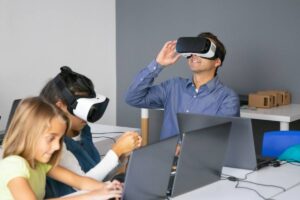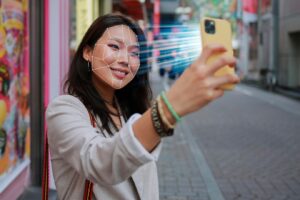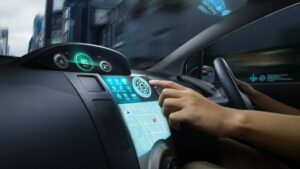The Technology Blog
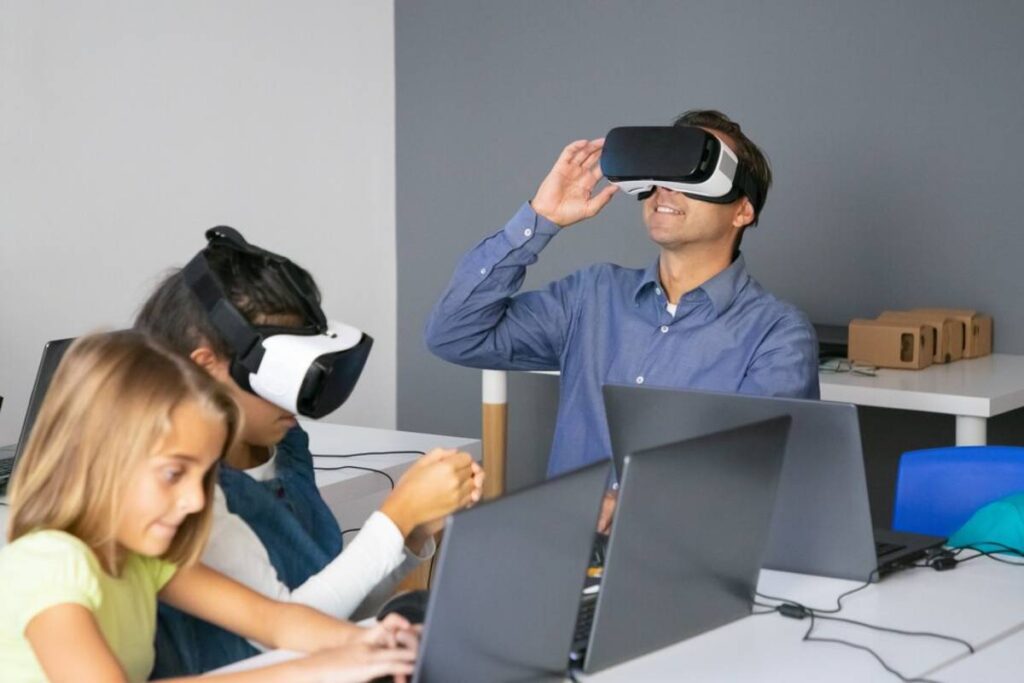
The Role of AR and VR in Modern Education
Learning has evolved dramatically in recent decades—from chalkboards to smartboards, from textbooks to tablets. AR (Augmented Reality) and VR (Virtual Reality) are bringing new possibilities to education. These technologies are not only a Hollywood or gaming thing. They are transforming classrooms, lecture halls, and training centres around the globe.
Using AR in classrooms and utilising VR learning tools helps one connect the dots between theory and practice. But you can fly through the solar system or dissect a frog without a scalpel. They are not just toys but powerful learning devices that impact how we learn and store information.
Let’s explore how AR and VR are changing the face of education. We’ll explore their advantages, real-world examples, difficulties, and how to implement them. As an educator, parent, or policy-maker, understanding these tools will be critical for keeping pace with digital learning.
So, let’s enter the exciting world of immersive education, where learning manifests!
What Are AR and VR? A Quick Refresher
Before diving deeper, let’s clarify that AR and VR are often used interchangeably but differently.
Augmented Reality (AR)
AR adds digital information—like images or data—into the real world. For example, think of apps that show historical facts when you point your camera at a monument.
Virtual Reality (VR)
VR creates a fully immersive, computer-generated environment. Students can explore and conduct experiments with headsets like the Meta Quest or HTC Vive. They can also simulate scenarios, such as medical surgeries or architectural walkthroughs.
Both technologies hold great promise. However, they are used in different ways. This depends on learning goals, available resources, and age groups.
Benefits of AR and VR in Education
Immersive technologies aren’t just impressive. They solve real educational problems and create new learning chances.
1. Enhanced Engagement and Motivation
Traditional teaching can struggle to engage digital-native students. AR and VR are fun and engaging. They spark curiosity, keep students focused, and make learning enjoyable.
A 2020 study by PwC showed that VR learners trained four times faster and felt 275% more confident in using their skills than traditional learners.
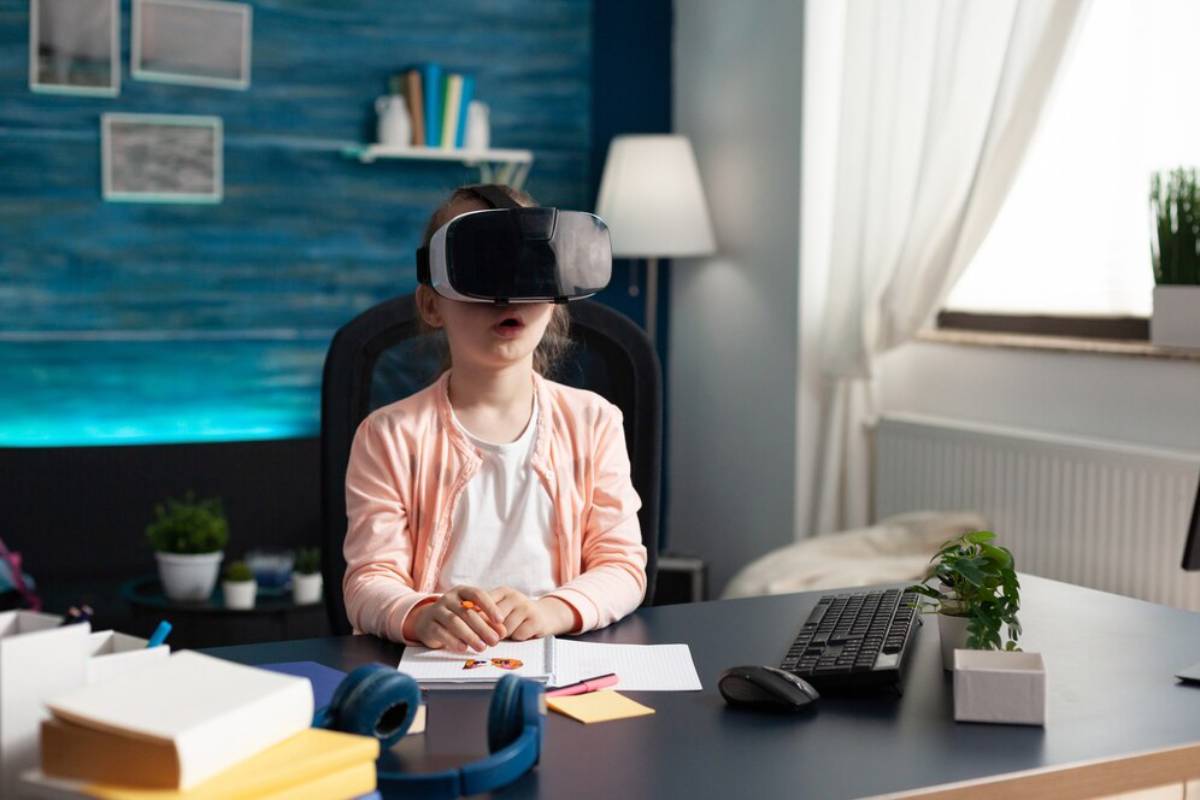
2. Learning by Doing
“Learning by doing” improves knowledge retention. VR simulates real-life environments, allowing students to practice tasks safely and repeatedly, whether surgery or coding.
Key Point: Experiential learning through VR can boost retention rates by up to 75%, compared to 10% for reading or lectures.
3. Making Abstract Concepts Concrete
Subjects like physics and biology often involve complex ideas. AR brings these concepts to life through 3D visualisations, making them easier to understand.
Example: In geometry class, students can use AR apps to manipulate and explore 3D shapes in real time.
4. Accessibility and Inclusivity
AR and VR can be customised for students with disabilities. VR can simulate mobility for physically impaired students, while AR apps can provide sign language overlays or visual cues for those with hearing impairments.
5. Global Collaboration and Virtual Field Trips
VR allows students to take virtual field trips to museums or historical sites without leaving the classroom. It also fosters global collaboration, connecting students and teachers in a shared virtual space.
Real-World Examples of AR and VR in Classrooms
Many institutions have adopted AR and VR to enrich education. Here are a few notable examples:
Google Expeditions (Now Merged into Google Arts & Culture)
Google Expeditions lets teachers take students on virtual field trips with low-cost VR headsets. Imagine visiting the Great Barrier Reef or the International Space Station without leaving your desk.
- Impact: Used in over 1 million classrooms worldwide before merging with other platforms.
- Benefit: A low-cost, scalable solution with extensive educational content.

Labster: Virtual Science Labs
Labster offers interactive 3D science simulations, allowing students to conduct biology, chemistry, and physics experiments.
- Use Case: Perfect for schools without physical lab setups.
- Statistic: Universities using Labster report 76% improved test scores.
zSpace: Augmented Reality STEM Learning
zSpace provides AR-enabled laptops and tablets for students to engage with 3D human anatomy models, physics simulations, and more.
- Target Audience: K-12 and higher education.
- Strength: Combines touchscreen, stylus, and glasses for varied interaction.
VictoryXR: Virtual Reality Campuses
VictoryXR creates fully immersive VR campuses with virtual lectures, lab experiments, and social interaction.
- Example: Over 50 US colleges now offer courses through VR classrooms.
- Application: This is especially relevant for remote learning and crisis education like COVID-19.
Challenges and Limitations of AR and VR in Education
While immersive education is exciting, it comes with challenges.
1. High Costs and Accessibility
VR headsets, AR devices, and specialised software can be costly, posing a challenge for underfunded schools.
- VR headset cost: £300–£700 per device
- Solution: Initiatives like Google Cardboard offer lower-cost alternatives with fewer features.
2. Technical Expertise
Teachers and IT staff often need training to use these technologies effectively. Without proper onboarding, valuable tools may go underutilised.
3. Content Availability and Curriculum Integration
Not all subjects have ready-made VR or AR content. Creating custom materials can be time-consuming and expensive.
- Need: More curriculum-aligned, plug-and-play solutions that teachers can easily adopt.
4. Motion Sickness and Discomfort
Some users may feel dizziness or nausea when using VR, especially for long periods. This can limit how often it can be used in classrooms.
How AR and VR Support Different Learning Styles
Every student learns differently. AR and VR can accommodate diverse learning preferences.
Visual Learners
- AR/VR Use: Interactive diagrams and immersive environments help visual learners grasp information quickly.
- Example: Anatomy students visualise organs in 3D instead of flat diagrams.
Kinesthetic Learners
- AR/VR Use: Hands-on virtual labs and simulations allow movement and interaction.
- Example: Engineering students assembling virtual mechanical parts using gestures.
Auditory Learners
- AR/VR Use: Narrated guides and virtual avatars enhance understanding.
- Example: Language learners engaging in VR conversations with AI tutors.
Social Learners
- AR/VR Use: Group activities in virtual spaces encourage collaboration.
- Example: Students co-creating projects in a shared VR whiteboard room.
Best Practices for Implementing Immersive Education
Integrating AR and VR in education requires careful planning. Here are some best practices:
1. Start Small and Scale Gradually
Begin with pilot programs in specific subjects or age groups before expanding school-wide.
- Tip: Choose tools with existing educational content to reduce development time.
2. Train Teachers and Provide Support
Invest in training workshops and tech support for teachers. Confident educators are more likely to embrace the technology.
- Recommended: Partner with providers offering onboarding support.
3. Prioritize Content Quality and Relevance
Ensure AR or VR experiences meet learning goals. A flashy app that doesn’t enhance understanding adds little value.
- Checklist:
- Does it match the curriculum?
- Is it age-appropriate?
- Is it easy to use?
4. Involve Students in Feedback
Gather student feedback to improve your immersive education strategies. Their insights can guide better implementations and content choices.
Common Concerns
Is AR better than VR for education?
Not necessarily. AR is generally more accessible and works on smartphones, making it ideal for quick activities. VR offers deeper immersion and is excellent for simulations. Both have their place depending on the learning goals.
Do you need expensive equipment to use AR or VR?
While high-end headsets can be costly, many apps run on smartphones and low-cost VR viewers like Google Cardboard. Educational grants can also help schools invest in better options.
Are AR and VR suitable for primary school students?
Yes, as long as the content is age-appropriate. Many platforms offer child-friendly AR apps for subjects like science and geography, allowing younger students to learn through play.
How do you assess student performance in immersive learning environments?
Assessment methods vary. Teachers can track performance through built-in analytics, quizzes, or follow-up assignments that test comprehension of AR or VR experiences.
Reimagining the Classroom for the 21st Century
In an age of soundbite culture, students need transferrable skills. AR and VR are explained in education to increase students’ interest and inspire them. They enhance conventional learning techniques and disrupt them with interactive, personalised, and immersive experiences.
Immersive education is now a reality. Medical schools are conducting virtual operations. Unlike primary schools, today’s classrooms are equipped with 3D projects so that students can explore ancient civilisations, and success only comes when technology integration is done carefully. There is a balance for schools to strike between ambition and accessibility. They need to concentrate on the training and the educational value to develop the most of these tools.
As we advance immersive education, the question isn’t whether AR and VR belong in classrooms. It’s about leveraging them to create a smarter, more interconnected generation of learners.
Are you ready to bring immersive education into your classroom? Identify tools and take baby steps in creating applications that change how your students learn.




